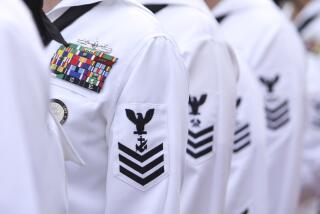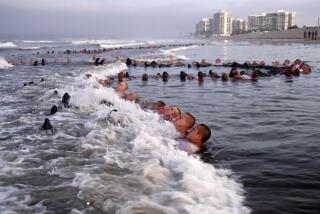Navy Spent $164,000 on Unsuitable Storage Boxes : The Military: An investigation is under way into the purchase that some officials say was merely a well-intentioned idea gone awry.
- Share via
The Navy in San Diego spent $164,000 on cold-storage boxes that were never used for pier-side refrigeration because the Navy lacked a large enough facility in which to chill them.
The 178 boxes were placed in an outdoor boat lot, where they rusted for two years. A few were used to store paint.
“It was a waste of government funds--that has been the conclusion from day one,” said Mary Giffin, director of management control and review at the Naval Supply Center in San Diego. “It was a poor decision made at the time. But I want to explain that we didn’t just take 178 boxes and throw them in the garbage, because we are utilizing them in other areas.”
The supply center’s acquisition of the refrigerator boxes illustrates the complexity of the Navy purchasing system and how it can sometimes go awry even when everyone involved had “the best intentions,” according to one Navy official.
A Senate Budget Committee report released last week says the armed services, including the Navy, have stockpiled $30 billion in unneeded military supplies in warehouses and storage lots. The committee’s chairman, Jim Sasser (D--Tenn.), said the stockpiling shows that “there are no incentives among purchasing people to save money.”
Naval Supply Center officials in San Diego purchased the insulated boxes in December, 1985. They hoped the purchase would save money by reducing the number of workers paid to wait by docks for ships and by cutting back the amount of fuel used by refrigerator trucks waiting with their engines running. The Navy calculated it would save $300,000 a year, according to an internal report.
The supply center provides food and supplies to 140 ships in San Diego and Long Beach and also services 344 shore facilities, such as the Navy Hospital in Balboa Park. The boxes, 4 feet by 4 feet by 7 feet, are designed to be chilled in a cold warehouse, loaded with food and taken to piers to await loading aboard ship.
But there were several glitches. The supply center didn’t have a facility large enough to chill the boxes. And the boxes, designed to keep food frozen for two days, didn’t work for longer than six hours, according to tests conducted by the supply center in the spring of 1985 before the purchase.
“Why would they buy them before they had a building to use them? And if they didn’t pass the specifications, why would they buy them?” asked Rep. Jim Bates (D-San Diego). “They wasted all that money--bungled the whole operation and then make lame excuses. We don’t need $1,000 paint lockers.”
In a December letter, Bates asked the naval inspector general, Rear Adm. Ming Chang, to investigate “the wasteful procurement of a product that NSC San Diego did not have the capability to use.”
An investigator from Washington left San Diego on Wednesday after spending several days looking into Bates’ allegations.
Although the center lacked a facility large enough to chill the boxes, construction of one had been planned since 1979, said Mary Markovinovic, a spokeswoman for the supply center. However, that plan never got off the drawing board. Money to build the warehouse was cut in 1986 or ‘87, after the purchase of the boxes, Markovinovic said.
The Naval Supply System Command in Washington earmarked funds for San Diego’s supply center to purchase the boxes, Markovinovic said. During the year they were bought, the supply center’s contracting department made $204 million in purchases. For it, the box contract--bid on by three companies--was relatively small.
Navy officials specified that they wanted the 178 insulated boxes to be able to hold a temperature of zero degrees Fahrenheit for a minimum of 48 hours. Before purchasing the boxes, the supply center’s staff tested them for four consecutive days, beginning May 14, 1985.
The boxes failed three tests, including one in which workers plugged the drain opening at the manufacturer’s suggestion. The tests showed that six hours was the maximum time the boxes could sustain a temperature of less than 15 degrees Fahrenheit, according to a letter from the supply center’s contracting officer, E. Davenport.
Davenport told manufacturer Bill Rivers about the failures in a letter dated May 20, 1985. Davenport wrote that he was returning the box and requesting more testing. The insulated boxes had “failed first article testing specifications miserably,” according to an internal report.
Rivers, whose company is based in Jacksonville, Fla., did not return repeated calls from The Times. It could not be determined whether Rivers changed the way the boxes were built after they failed Navy tests.
In a memo dated Dec. 3, 1985, Cmdr. Joseph Palanuk, director of the supply center’s materiel department, gave approval for the boxes to be delivered, documents show. The boxes were shipped to the center in batches, the last lot of nine delivered April 29, 1986.
Supply center officials say they cannot explain why the purchase was made after the boxes failed tests, because a crucial file is missing.
“We do not have the file. We do not know the exact reasons why Palanuk approved it,” Giffin said. “We just don’t have those records.”
According to a 1988 report by a supply center auditor, “There are some serious questions as to why first article tests were approved by Cmdr. J. E. Palanuk.”
When reached by the in-house auditor, Palanuk said “he was not aware of or does not recall any first article temperature test results,” according to a July, 1988, memo.
Palanuk, reached at his home in Crystal City, Va., where he now works at the Navy Accounting Finance Center, declined to comment about the purchase.
In 1984 and 1982, the Naval Supply Center in San Diego received a Navy-wide award for productivity. And, in 1984, Palanuk was one of 20 employees selected from 1,700 for helping earn the award.
“Cmdr. Palanuk has been the catalyst in achieving significant gains in both quality and quantity of work performed,” according to the award description. “His leadership has resulted in an aggressive program to improve the quality of life throughout the warehouse operations.”
Besides not staying cold enough, the boxes had another problem, the Navy discovered. Officials had specified that the units be designed so a forklift could place pallets laden with food into the boxes. A design flaw, however, made it impossible to use forklifts, according to the supply center audit. Unable to use the boxes, which cost $920 apiece, officials decided to store them in the outdoor boat lot.
“All containers appear to be in a state of deterioration. Rust was found on all containers in varying degrees,” according to the audit report, dated May 20, 1988.
The boxes stayed in the lot for two years, until an anonymous complaint was lodged with the supply center’s fraud hot line in the spring of 1988. An in-house investigation was launched and the local Naval Investigative Services also looked into the incident.
“It was referred to us; we did a preliminary inquiry and determined there was no criminality involved,” NIS special agent Stephen Kahl said. Everything may not have gone the way it should have, “but it was not criminal. We had no evidence that anyone profited by it.”
The hot line report recommended that the boxes be properly stored and offered to other commands. Two months later, boxes were shipped to Subic Bay, Pearl Harbor, Puget Sound, Pensacola and Charleston. Giffin said she did not know how or if other commands were using the boxes.
None of the officials associated with the purchase was reprimanded.
“There was no one to really sanction,” Markovinovic said. “It was something done with the best intentions; it just didn’t work out.”
The center now has 24 boxes, Markovinovic said. Half are used to hold food transported by truck to Long Beach. Half are used by the materiel storage department, she said. And some of those are used as paint lockers.
“Although the original plan did not occur, the government has utilized these boxes in other ways. We did not just flush $170,000 down the toilet. These boxes are being used,” Markovinovic said. “It may have been a poor decision at the time, but the government is making every effort to utilize what we have.”
More to Read
Sign up for Essential California
The most important California stories and recommendations in your inbox every morning.
You may occasionally receive promotional content from the Los Angeles Times.










